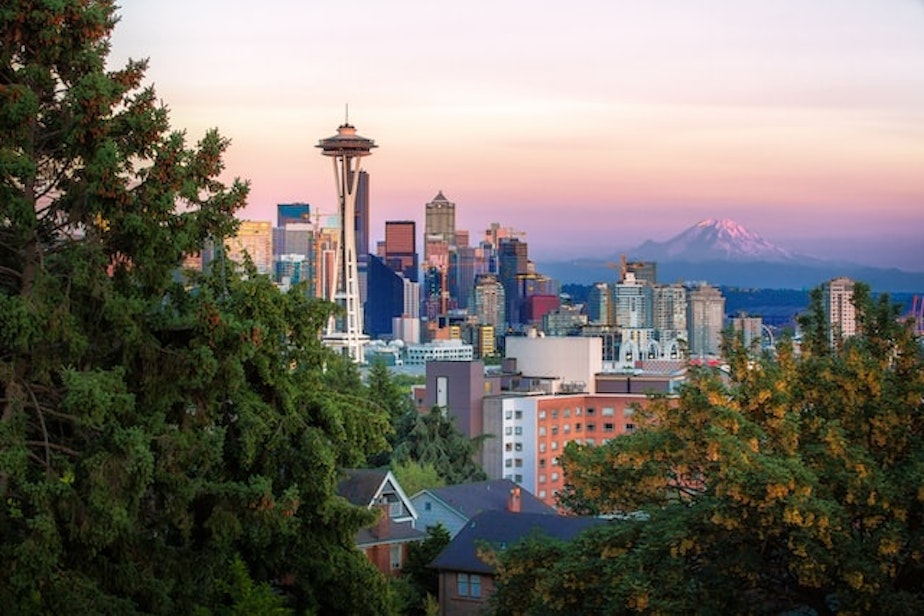Seattle's urban forest is shrinking. How can it grow?

In 2007, Seattle's urban forest management plan set a goal for 30% of the city to be canopied, meaning covered with urban trees.
However, a recent report from the city showed that Seattle's canopy actually decreased by 1.7% over the last five years – that's 255 acres, an area roughly the size of Green Lake.
To learn more, Soundside spoke with Patti Bakker, interim urban forestry policy advisor with the Office of Sustainability, and Environment; Deb McGary, an arborist with the City of Seattle; and Jana Dilley, an urban forester with Seattle Public Utilities.
The city measures changes in canopy coverage every five years. In 2016, the Urban Forestry Commission found that 28.6% of Seattle was canopied. 2021's canopy assessment found the current canopy cover to be 28.1%.
The biggest loss of trees occurred in Seattle’s parks and natural areas, according to the report, followed by residential neighborhoods.
Seattle's population increased by 8.5% in that same span.
"We see large construction projects for utilities, transportation, and other infrastructure," Bakker said. "We have these aging trees that are more susceptible to drought conditions and pests that are more likely to come down during weather events."
Sponsored
The balance between urban growth and canopy preservation is a central tension in conversations about canopy coverage.
The city's municipal code has certain protections for what are called "exceptional trees," meaning "a tree or group of trees that because of its unique historical, ecological, or aesthetic value constitutes an important community resource...." Removal of exceptional trees in a single-family, low-rise, mid-rise, or commercial zone requires a permit from the Seattle Department of Construction and Inspections (SDCI).
These trees are protected based on the size of the species, and developers are expected to build in ways that protect the health of exceptional trees. However, there are exceptions for developers to remove exceptional trees based on neighborhood zoning rules. In the case of removal, the municipal code requires all trees over 24 inches to be replaced with trees that will eventually, when mature, provide a comparable canopy.
"There are certainly ways to be creative, and to develop around trees," arborist Deb McGarry said. "I'm not saying it's always possible."
The current tree-protection ordinance is based on an interim ordinance from 2009, and arborists and tree-preservation advocates in the region have criticized it for vague language and loopholes that allow developers to remove more trees in the region.
Sponsored
Sean Watts, a conservation ecologist and environmental consultant, told KUOW's Seattle Now podcast that while the city may replace exceptional trees during development, those new trees frequently die shortly after being planted, which is a net loss of canopy cover.
In addition, research from the urban forestry core group found that in 2017 there was tree mislabeling going on, where developers misled the city on a tree's size in their application for a removal permit.
Regarding enforcement, McGarry said the city is aware that trees are illegally removed. In the case of mislabeling, she said the city cross-references listed measurements with the view of a tree from Google street view. The city also has a public phone number where they take complaints and reports regarding illegal tree removal.
"There is never going to be enough enforcement to stop that entirely," McGarry said.
Earlier this year, to improve transparency in tree removal, the Seattle City Council passed a bill requiring tree service providers, which includes tree-removal companies and arborists, to join a public registry before heavily pruning or cutting down trees. The council is also looking at changes to current tree-protection guidelines, including an inch-for-inch trunk replacement rule.
Sponsored
There are currently nine agencies that oversee Seattle's urban forest, and city council members have also expressed frustration with the "fractionalized" approach to urban forestry in the region.
There have been several attempts to update the 2009 tree ordinance in the past, and the city council is currently hearing multiple draft proposals from the Urban Forestry Commission (UFC) and the Seattle Department of Construction and Inspection (SDCI). The SDCI proposal calls for trees with diameters of 12 inches or more to be protected. The UFC proposal would reduce that to six inches or more.
Under the proposed new rules, "there would definitely be more trees protected, or required to be mitigated if they're removed," Patti Bakker said. "So it would result in potentially more larger trees retained and more trees added to the canopy."
The latest canopy cover assessment also reaffirmed that canopy coverage is spread unevenly through the city. Maps provided in the latest city report show generally higher levels of canopy coverage in north Seattle neighborhoods, while areas like South Park, Georgetown, Beacon Hill, and Rainier Valley lag behind.
"There's a long history of how these areas came to have low canopy, including past processes such as redlining and placement of heavy transportation corridors," Bakker said, "as well as lack of investment in those neighborhoods compared to others."
Sponsored
A lack of tree cover, and the shade canopies provide, can lead to patches of increased average temperatures, also known as heat islands. The city currently partners with local groups like the Duwamish Valley Youth Corps to distribute tree-planting resources and increase canopy coverage in South Seattle.
Listen to Soundside's full conversation by clicking the audio above.





